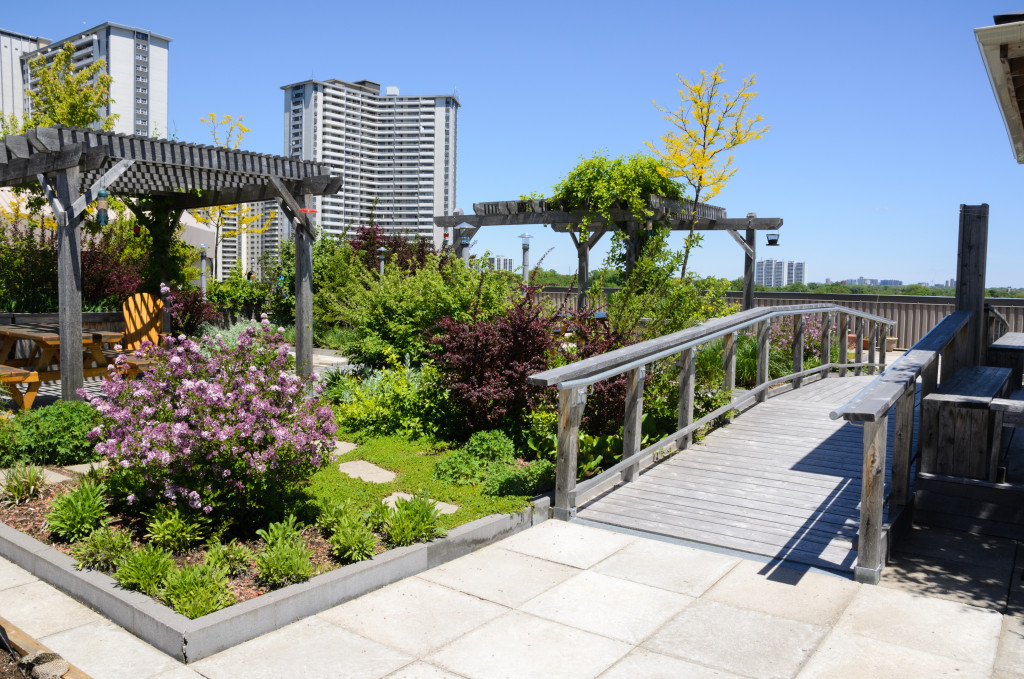- Plant selection should be tailored to the environment and climate to ensure success.
- Rainwater harvesting systems, drip irrigation, and sensors can help promote plant health.
- Professional installation is recommended for larger or more complicated gardens.
- Rooftop gardens are becoming a popular and sustainable addition to many corporate buildings.
In this day and age, rooftop gardens are becoming a popular addition to many corporate buildings. Not only do they make the building look more aesthetically pleasing, but they also come with a host of other benefits.
Employees and tenants of the building can enjoy spending their time in the garden, which helps to increase morale. This blog post will discuss the advantages of installing a rooftop garden in your corporate building and share some tips on creating a successful one.
Reducing Urban Heat Islands
Urban heat islands (UHIs) are regions in cities that experience much higher temperatures than nearby rural areas due to human activity. This can be caused by the concentration of concrete and asphalt surfaces which absorb heat throughout the day and release it at night, trapping warmth in the city center. This phenomenon is particularly noticeable during summer when temperatures can be up to 8°C hotter than surrounding areas.
Rooftop gardens can help reduce UHIs by providing shade and cooling effects; plants absorb sunlight and convert it into energy which cools down air near the ground level. Additionally, green roofs can decrease wind speeds near ground level and filter out pollutants from the air.
Improving Air Quality

Rooftop gardens not only help reduce UHIs; they also improve air quality by filtering out dust and other pollutants from entering indoors. Studies have shown that green roofs can reduce airborne particulate matter concentrations by up to 70%, improving people’s respiratory health significantly. Furthermore, green roofs also act as natural carbon dioxide sponges absorbing excess CO2 from the atmosphere, contributing to healthier air quality overall.
Lowering Building Temperatures
In addition to reducing UHIs, rooftop gardens also help keep building temperatures cooler during hot summer due to their insulating properties. Green roofs act like an additional layer of insulation on the roof, preventing heat from entering or leaving the building while simultaneously providing an aesthetically pleasing view for those inside.
Rooftop gardens have been found to reduce indoor temperatures by up to 4-5°C during peak times, making them an invaluable addition for any corporate building looking to save money on cooling costs while keeping employees comfortable during work hours.
Creating a Rooftop Garden
Once you install a rooftop garden, it’s time to start planning for it. Building the perfect rooftop garden requires careful consideration of what plants will be planted, the design of the garden, and how it will be installed. Here are some tips to help you get started:
Water source
Before you start planting, you need to consider what type of water source will be used for the garden. After all, a garden will not thrive without proper hydration. Many rooftop gardens use rainwater harvesting systems and/or drip irrigation to keep the garden watered.
They also invest in submersible water pressure transducers to ensure that the water pressure is optimal for the plants. This type of sensor can detect changes in water pressure, alerting you when the system needs to be adjusted.
Plants

When selecting plants for your rooftop garden, it is important to consider which plants will thrive best in the environment. Sun exposure, wind patterns, and local climates affect what grows best, so research is key. You should also look into drought-tolerant plants and native species that require less maintenance.
Soil Type
The soil type used in a rooftop garden largely depends on your growing plants and your region’s climate. Make sure to use a soil mix that is light enough for easy drainage but also contains adequate nutrients for healthy plant growth. Additionally, consider using mulch to protect the soil from high temperatures, conserve moisture, and reduce weeds.
Installation
Installing a rooftop garden can be a complex process due to the many variables involved in getting it just right. Professional installation is recommended for larger or more complicated gardens. Hiring an experienced contractor can help ensure that your garden is properly constructed and maintained over time.
With so many benefits ranging from improved air quality and reduced urban heat islands to lower building temperatures and energy savings, it is clear why there has been such a surge in the popularity of rooftop gardens in corporate buildings around the world! If you are looking for ways to make your business more sustainable, investing in a green roof is definitely something worth considering!

